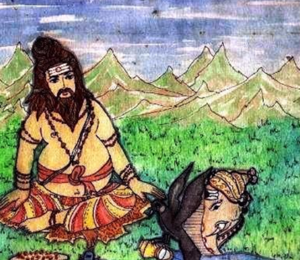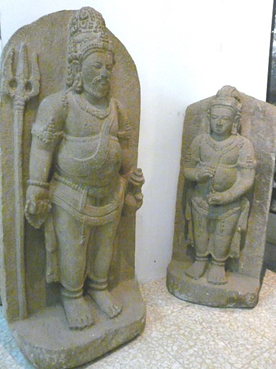Talk:Ṛṣi Agastya: How Hindu culture was spread all over India and abroad
By Vishal Agarwal
Some Ṛṣis are said to have lived a very long life. One of them was Ṛṣi Bharadvāja. A beautiful story is narrated about his love for the study of the Vedas. He spent his long life of 100 years studying the Vedas.
Pleased with his love for the Śāstras, the king of the Devas named Indra appeared before the Ṛṣi and asked: "If I were to increase your life by another 100 years, what would you want to do?" Ṛṣi Bharadvāja replied, "I would spend the next 100 years again in studying the Vedas." Indra increased his life, and returned to see the Ṛṣi when he was 200 years old.
Indra then asked Ṛṣi Bharadvāja, "And if I were to increase your life by another 100 years, then?" The Ṛṣi said, "I would like to spend my next 100 years too to continue studying the Vedas."
Indra then created three mountains of sand in front of the Ṛṣi, and said, "These three mountains represent the Ṛgveda, Yajurveda and Sāmaveda. And from each mountain, your study is but a fistful of sand because endless are the Vedas (anantā vai vedāḥ). The more we study these Śāstras, the more new things we learn every time."
Ṛṣi Bharadvāja was amazed, and realized that there is no end to studying the Śāstras. Indra was pleased and said, "Well, you have studied enough. You will now reach Bhagavān very soon."
Today, people regard Ṛṣi Bharadvāja as one of the seven greatest Ṛṣis who ever lived. He was respected a lot. Even Bhagavān Rāma went to visit him at the beginning as well as at the end of his fourteen-years-long exile in the forest, out of respect.
People of Indonesia believe that Ṛṣi Agastya came to visit their country from South India, and brought the Hindu culture to them. Therefore, the Ṛṣi was worshipped in Indonesia. Archaeologists[1] have found mūrtīs of Ṛṣi Agastya in old temples of Indonesia, one of which is shown on the right.
The life of Ṛṣi Agastya shows that like him, we must take our culture wherever we go and share its good things with others. But do you remember how he did it? He did not impose his own Saṃskṛta language on others. Instead, he wrote the grammar of the Tamil language that people spoke in a region in South India, and wrote his books on medicine etc., in Tamil.
Similarly, when we move to a new region, we must not destroy the culture of that place or impose our own culture there. Instead, we should learn the language and culture of our new home, and also teach our own culture to the people there. And just like Agastya gave many good things to his new home, like the Siddha medicine, the Kāverī River, Tamil Grammar and so on, we should also contribute positive things wherever we go.
References[edit]
- ↑ An archaeologist is a trained person who explores ancient places, digs out old objects from under the ground, and studies them scientifically to understand how people of that area had lived in the past.


